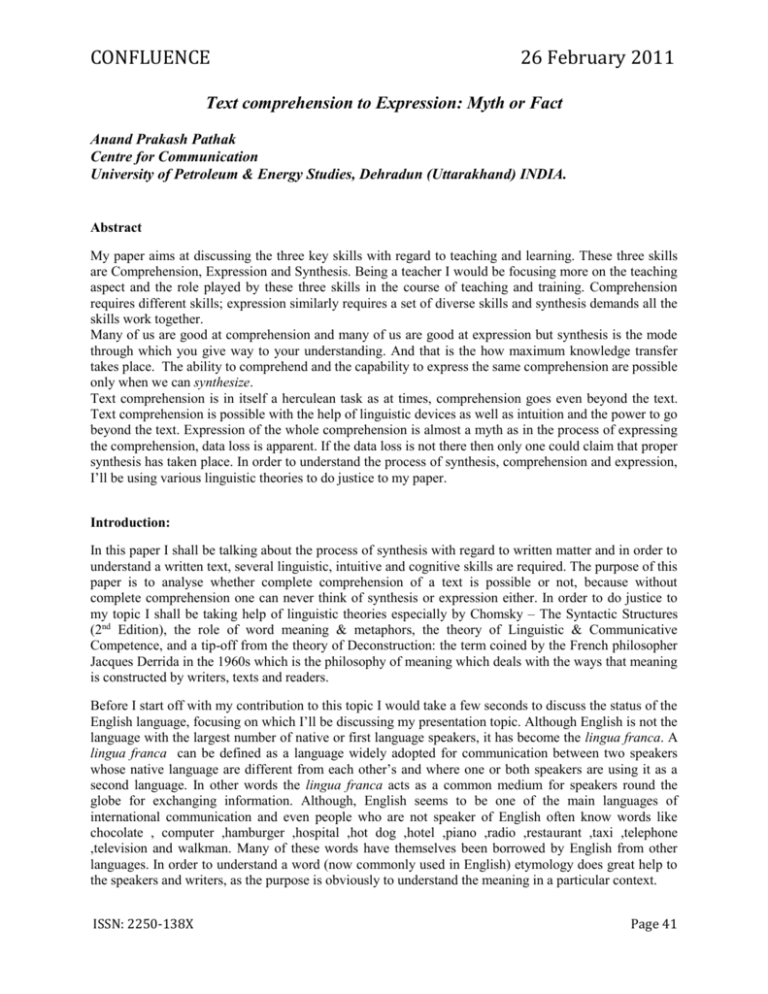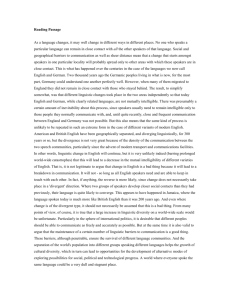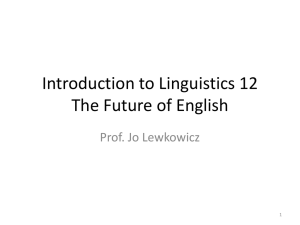speakers comprehension
advertisement

CONFLUENCE 26 February 2011 Text comprehension to Expression: Myth or Fact Anand Prakash Pathak Centre for Communication University of Petroleum & Energy Studies, Dehradun (Uttarakhand) INDIA. Abstract My paper aims at discussing the three key skills with regard to teaching and learning. These three skills are Comprehension, Expression and Synthesis. Being a teacher I would be focusing more on the teaching aspect and the role played by these three skills in the course of teaching and training. Comprehension requires different skills; expression similarly requires a set of diverse skills and synthesis demands all the skills work together. Many of us are good at comprehension and many of us are good at expression but synthesis is the mode through which you give way to your understanding. And that is the how maximum knowledge transfer takes place. The ability to comprehend and the capability to express the same comprehension are possible only when we can synthesize. Text comprehension is in itself a herculean task as at times, comprehension goes even beyond the text. Text comprehension is possible with the help of linguistic devices as well as intuition and the power to go beyond the text. Expression of the whole comprehension is almost a myth as in the process of expressing the comprehension, data loss is apparent. If the data loss is not there then only one could claim that proper synthesis has taken place. In order to understand the process of synthesis, comprehension and expression, I’ll be using various linguistic theories to do justice to my paper. Introduction: In this paper I shall be talking about the process of synthesis with regard to written matter and in order to understand a written text, several linguistic, intuitive and cognitive skills are required. The purpose of this paper is to analyse whether complete comprehension of a text is possible or not, because without complete comprehension one can never think of synthesis or expression either. In order to do justice to my topic I shall be taking help of linguistic theories especially by Chomsky – The Syntactic Structures (2nd Edition), the role of word meaning & metaphors, the theory of Linguistic & Communicative Competence, and a tip-off from the theory of Deconstruction: the term coined by the French philosopher Jacques Derrida in the 1960s which is the philosophy of meaning which deals with the ways that meaning is constructed by writers, texts and readers. Before I start off with my contribution to this topic I would take a few seconds to discuss the status of the English language, focusing on which I’ll be discussing my presentation topic. Although English is not the language with the largest number of native or first language speakers, it has become the lingua franca. A lingua franca can be defined as a language widely adopted for communication between two speakers whose native language are different from each other’s and where one or both speakers are using it as a second language. In other words the lingua franca acts as a common medium for speakers round the globe for exchanging information. Although, English seems to be one of the main languages of international communication and even people who are not speaker of English often know words like chocolate , computer ,hamburger ,hospital ,hot dog ,hotel ,piano ,radio ,restaurant ,taxi ,telephone ,television and walkman. Many of these words have themselves been borrowed by English from other languages. In order to understand a word (now commonly used in English) etymology does great help to the speakers and writers, as the purpose is obviously to understand the meaning in a particular context. ISSN: 2250-138X Page 41 CONFLUENCE 26 February 2011 I am going two-three decades back to cite Braj Kachru (1985) who suggested between 320-380 million people spoke English as a first language where as 250-350 million spoke English as a second language. On the other hand David Crystal (1995-1997) calculated around 377 million first language speakers and only 98 million as second language speakers. However he points out that it would be easy to get nearer a total of 350 million for second language speakers if we are able to calculate how many speakers of English as a second language there were in say, Canada or Australia or in countries like Pakistan or Nigeria. In 1983, however, Kachru made a prediction which if correct, means that there are now more second language speakers than first language. To quote him, “One might hazard a linguistic guess here. If the speed of English continues at the current rate, by the year 2000 its non-native speakers will outnumber its native speakers”. I do hope that all us would unanimously agree that the rate has increased always and now the number of non-native speakers or the second language speakers is almost nearing the double of that of the first language speakers. Now, I’ll be talking about the most important part of my presentation – Comprehension. Comprehension is something which is expected at all the three levels of communication viz. written, verbal and non verbal. Writing is narrow an compared to speech because it is nothing but one modality among others, a modality of the events, which can befall a language whose essence, as the facts seem to show, can remain forever uncontaminated by writing. To quote Derrida from “Of Grammatology (1967)”, “Language does have an oral tradition that is independent of writing”. Saussure takes up the traditional definition of writing which, already in Plato and Aristotle, was restricted to the model of the phonetic script and the language of words. Let us recall the Aristotelian definition “Spoken words are the symbol of mental experiences and written words are the symbol of spoken words”. Saussure says “Language and writing are two distinct system of signs; the second exists for the sole purpose of representing the first”. A very important and indispensable part of Synthesis is the Word Meaning. The least problematic issue of vocabulary, it would seem, is meaning. We know that Table means a thing with legs which we can write on and eat off and that a Book is a collection of words between covers. But, of course, this is not the end of the story at all. For example, the Cambridge International Dictionary of English lists three main meanings for Table and four main meanings for Book – let alone the large number of different phrases the words appear in where there meaning is subtly different. You can eat off a table, or you can table a motion at a conference. You can summarize information in a table too. Then again, when you have read your book, you can ring up a restaurant and book a table but if you drive too fast on the way you might be booked for speeding some people have been keeping a book on whether you’ll ever manage to persuade your boy/girl friend to marry you, since everyone knows you have been cooking the books for years – says J. Harmer in his book on English Language Teaching) – The point is that same collection of sounds and letters can have different meanings. This ambiguity is only resolved when we see the word in context. Coming to metaphors – some metaphors become fixed in to phrases which competent speakers recognize at once, even though the meaning of the phrase is not decipherable from any understanding of the individual words. We all know that She kicked the bucket means She died and He has bitten off more than he can chew means he has attempted something that is more difficult for him. Some metaphors are so common in use that now they have become clichés and some are still unfathomed – talking from a second language speaker’s point of view. But the meaning these metaphors offer to a piece of writing cannot be overlooked; if for no other reason than at least for this that without proper interpretation of the text, both synthesis and expression remain unattainable. Once we try to understand a written matter, various means come into play. Chomsky’s “Syntactic Structures” is of great help in understanding the role played by grammar and semantics in the process of text comprehension. Says Chomsky, “To understand a sentence we must know much more than the analysis of the sentence on each linguistic level. We must also know the reference and meaning of the morphemes or words of which it is composed: naturally, grammar cannot be expected to be of much help ISSN: 2250-138X Page 42 CONFLUENCE 26 February 2011 here.” He further adds to it by insisting on the fact that Grammar is best formulated as a self-contained study independent of Semantics. In particular, the notion of Grammaticalness cannot be identified with Meaningfulness (nor does it have any special relation, even approximate to the notion of statistical order of approximation). More generally, it appears that the notion of “Understanding a sentence” must be partially analysed in grammatical terms. To understand a sentence, it is necessary (though not, of course, sufficient) to construct its representation on each level, including the transformational level where the kernel sentences underlying a given sentence can be thought of, in a sense, as the “elementary content elements” out of which the sentence is constructed. Language and Communication are two modes of expression and the link between the two is Cognition. Use of language to communicate is achieved through cognition. It is not only important to know the language, but also the use of the language. Knowing a language is a part of the Linguistic Competence (mentally represented grammar of that language) while conveying the message with appropriate meaning is a part of the Communicative Competence. It demands knowledge of Semantic features apart from the grammatical structure. Ex: 1. The boy ate the cake. 2. The cake ate the boy. Observation: Sentence 1 adheres to the appropriate grammatical structure as well as the semantic rules. Sentence 2 adheres to the appropriate grammatical structure but violates the semantic rules. To say, linguistic competence exhibits itself in both the sentences, but only sentence 1 has linguistic as well as communicative competence. Similarly, intuition and cognition play an important role in the synthesis of meaning. For ex.: a. Shooting of the hunters. b. Shooting of the lions. Both expressions are structurally alike but are understood differently. And we owe this difference in understanding to intuition and cognition. Similarly, we have our own cultural backgrounds and personal belief systems. One creates meaning and the other assigns meaning as the medium is same. Unless we “share” it is neither synthesis nor communication. Assigning meaning to an utterance is not exactly a purely linguistic process i.e. Phonology, Syntax, Semantics, Pragmatics, etc. it requires some other resource as well. From the above I would like to conclude by saying that without complete comprehension, synthesis is not possible and without synthesis one cannot think of expression, because at the end of the day, one uses the same means to understand and to express. The base is, understanding of the text, which requires several competencies for deciphering it. For it one requires the knowledge of all the means contributing towards the meaning and understanding of a given text. Lack of knowledge of a single means may mar the purpose and the target of complete synthesis and appropriate expression remains a myth forever because it is a journey from understanding to expression which makes synthesis take place. ISSN: 2250-138X Page 43






